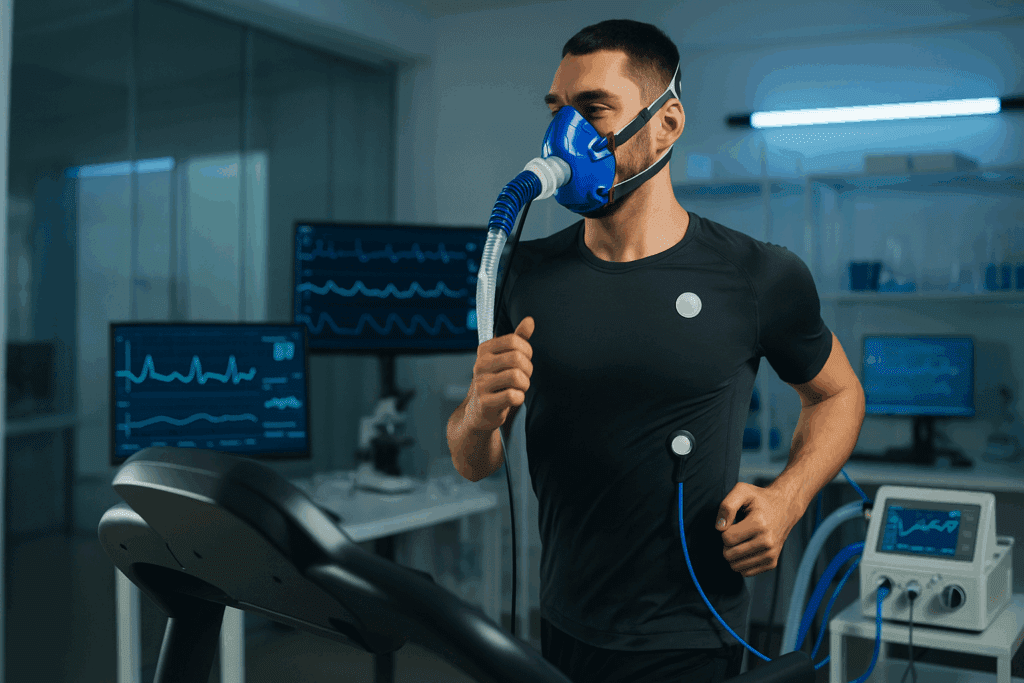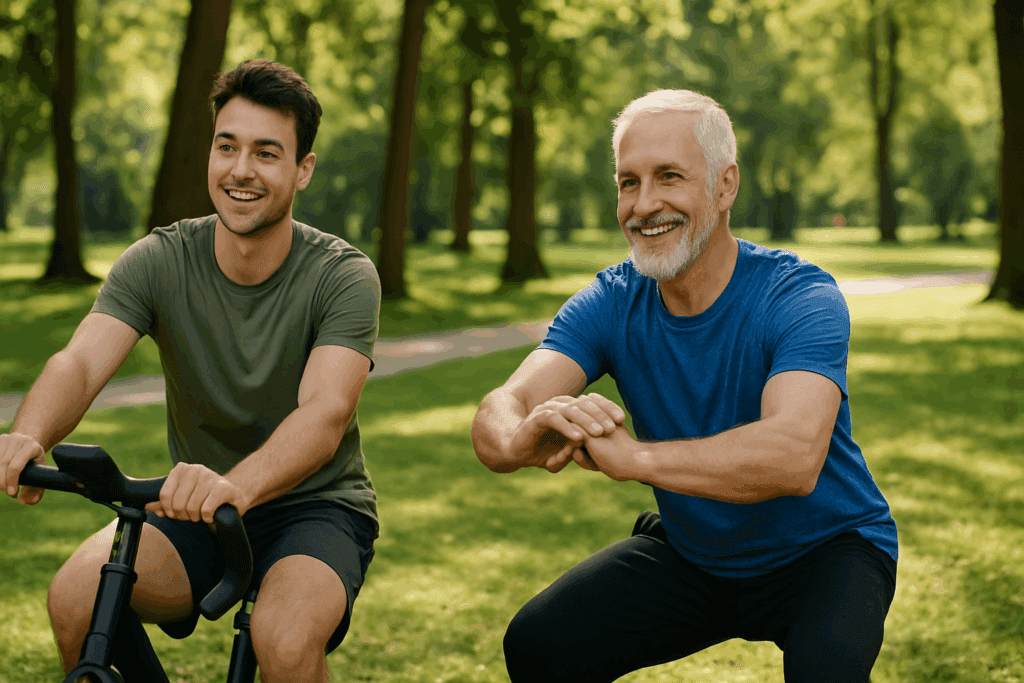Introduction: The Power of High-Intensity Interval Training for Men
High-Intensity Interval Training, better known as HIIT, has emerged as a cornerstone of modern fitness for men aiming to build muscle, burn fat, and boost cardiovascular health. With a unique structure that alternates between bursts of intense effort and periods of recovery, HIIT presents a time-efficient yet highly effective workout strategy. For men juggling careers, family responsibilities, and social obligations, this method delivers maximum return on investment without requiring hours in the gym. More importantly, HIIT workouts for men are versatile, adaptable, and scalable across fitness levels, making them an accessible and sustainable option.
You may also like: How to Increase Stamina and Endurance Naturally: Smart Training Tips and Nutrition Habits That Support Cardiovascular Fitness
What sets HIIT apart is not just its convenience, but its scientifically validated capacity to transform physical health. Research consistently shows that HIIT can significantly improve cardiovascular function, insulin sensitivity, and metabolic rate. For men seeking to elevate their athletic performance while maintaining lean body mass, these adaptations are particularly advantageous. Moreover, HIIT training men in controlled formats fosters greater discipline, resilience, and long-term motivation—traits that extend beyond physical gains. As the conversation around fitness shifts from aesthetics to holistic performance, HIIT emerges as a natural ally in promoting sustainable and enduring wellness.
This article explores the physiology, science, and practical application of HIIT exercises for men, delving into how these workouts enhance strength, stamina, and performance. It also examines real-world strategies for integrating HIIT into a busy lifestyle, the biological mechanisms behind its success, and how men at different stages of life can safely harness its benefits. Grounded in expertise, experience, and evidence, this guide provides a comprehensive lens through which readers can assess the role of HIIT in optimizing male health.

Understanding the Science Behind HIIT
At the core of HIIT lies a simple but powerful concept: alternating high-intensity efforts with periods of lower-intensity recovery. During intense intervals, the body is pushed to near-maximal exertion, often reaching 80–95% of one’s maximum heart rate. These exertions stimulate both aerobic and anaerobic energy systems, which translates to better endurance and increased muscle efficiency. The recovery phases, while less intense, are critical for clearing lactate, restoring heart rate, and preparing the body for the next effort. This dynamic push-pull cycle creates metabolic stress that catalyzes physiological adaptation.
One of the key advantages of HIIT workouts for men is their ability to improve VO2 max—a measure of the body’s capacity to consume oxygen during exercise. VO2 max is not only a marker of cardiovascular fitness but also an important predictor of longevity and disease risk. By challenging the cardiovascular system repeatedly within a single session, HIIT stimulates rapid gains in heart and lung function. Additionally, HIIT triggers what is known as the “afterburn effect” or excess post-exercise oxygen consumption (EPOC), where the body continues to burn calories long after the workout ends.
From a hormonal perspective, HIIT also promotes favorable shifts. Testosterone levels often rise following HIIT sessions, contributing to increased muscle mass and libido. Growth hormone, another anabolic agent, is also released in greater quantities, supporting fat loss and recovery. These hormonal responses make HIIT exercises for men particularly potent for body composition management. Importantly, HIIT also helps regulate cortisol, a stress hormone that can contribute to abdominal fat and systemic inflammation when chronically elevated.

HIIT for Strength: Building Muscle with Intensity
While HIIT is often associated with cardio, it is equally effective for developing muscular strength. By incorporating bodyweight movements like push-ups, jump squats, and burpees, or integrating resistance tools such as kettlebells and dumbbells, men can stimulate hypertrophy within a metabolic framework. This dual focus allows for lean muscle gains without the bulkiness or joint stress associated with heavy lifting. The key lies in exercise selection and programming—choosing compound movements that recruit multiple muscle groups under high tension.
The concept of time under tension is particularly relevant here. In a HIIT context, performing strength-based exercises at high intensity within timed intervals enhances both muscular endurance and force production. For instance, a 30-second set of kettlebell swings followed by a 15-second rest can tax the posterior chain while maintaining elevated heart rates. Over time, this method leads to improved intramuscular coordination and neuromuscular efficiency. It also allows for better muscle fiber recruitment, including the fast-twitch fibers critical for explosive strength.
Another advantage of HIIT training men for strength is its neuroendocrine impact. Resistance-based intervals stimulate the central nervous system, leading to adaptations in motor unit firing and muscular activation patterns. This results in better coordination, quicker reaction times, and greater overall power output. Unlike traditional bodybuilding, which often isolates muscle groups, HIIT promotes integrated strength that reflects real-world physical demands. This functional strength improves posture, reduces injury risk, and enhances athletic performance.

HIIT for Stamina: Conditioning the Cardiovascular System
Endurance, often misunderstood as the ability to run long distances, is more accurately defined as the capacity to sustain effort over time. HIIT uniquely conditions this capacity by training the heart to pump more efficiently and the muscles to utilize oxygen more effectively. Repeated intervals of exertion challenge the cardiovascular system to adapt, resulting in lower resting heart rates, improved stroke volume, and greater oxygen delivery. These adaptations are particularly beneficial for men involved in recreational or competitive sports.
Furthermore, HIIT exercises for men target both central and peripheral components of endurance. Centrally, the heart and lungs become more robust. Peripherally, capillary density within the muscles increases, enabling better nutrient exchange and waste removal. Mitochondrial biogenesis—the formation of new energy-producing organelles within cells—is another key benefit. This allows for enhanced energy efficiency, making physical activity feel easier and reducing fatigue during daily tasks.
Unlike steady-state cardio, which can be monotonous and time-consuming, HIIT offers variety and excitement. It taps into different movement patterns, energy systems, and mental focus zones. For example, alternating between sprint intervals, jump rope drills, and stair climbs keeps the workouts dynamic while continuously challenging the cardiorespiratory system. This variety also reduces the risk of overuse injuries commonly associated with repetitive endurance training. For men aiming to maximize results in minimal time, HIIT provides a superior conditioning strategy.
HIIT for Performance: Enhancing Athletic Potential
Performance enhancement in sports and fitness contexts requires a multifaceted approach—one that includes strength, speed, agility, and mental resilience. HIIT delivers across all these dimensions. By training at or near maximal intensity, men improve their lactate threshold, or the point at which fatigue-inducing lactic acid accumulates. Raising this threshold enables athletes to perform at higher intensities for longer durations. This is particularly advantageous in sports like soccer, basketball, and martial arts, where short bursts of effort are interspersed with brief recovery.
Agility, another crucial component of athletic performance, is also sharpened through HIIT. Drills that involve directional changes, lateral shuffles, and plyometric jumps improve proprioception and neuromuscular coordination. These exercises enhance reaction time and movement efficiency, translating to quicker footwork and sharper decision-making during play. The mental focus required to push through intervals also cultivates psychological toughness—an often overlooked but essential aspect of peak performance.
From a metabolic standpoint, HIIT optimizes energy system utilization. The body becomes adept at switching between anaerobic and aerobic states, conserving glycogen and relying more on fat as a fuel source. This flexibility enhances overall endurance and reduces the risk of early exhaustion. HIIT training men with sport-specific drills allows athletes to simulate game-like conditions, building skills under fatigue and improving real-time responsiveness. These improvements make HIIT an indispensable tool in the athletic toolkit.

Adaptability Across Life Stages and Fitness Levels
One of the greatest strengths of HIIT lies in its adaptability. Men in their twenties may pursue high-intensity sessions focused on performance gains, while those in their forties or fifties may prioritize mobility, fat loss, or metabolic health. HIIT can be tailored to suit these goals by adjusting work-to-rest ratios, selecting joint-friendly exercises, or using low-impact modalities such as cycling or rowing. This customization ensures that HIIT remains safe, effective, and relevant throughout the male lifespan.
Beginners can ease into HIIT by starting with shorter sessions and simpler movements. Even basic exercises like brisk walking, bodyweight squats, or modified push-ups can form the basis of an effective HIIT workout when structured with intention. As fitness improves, intensity and complexity can be gradually increased. This scalable nature reduces the risk of injury and promotes sustainable progress, making HIIT exercises for men ideal for both novices and seasoned athletes.
Moreover, HIIT accommodates diverse health profiles. For men managing chronic conditions such as hypertension, prediabetes, or obesity, medical supervision combined with low-impact HIIT can yield significant benefits. Studies have shown that even modified HIIT protocols can improve insulin sensitivity, reduce visceral fat, and enhance quality of life. By aligning with a man’s unique needs, HIIT creates a personalized pathway to health that is empowering and sustainable.

Implementing HIIT in a Busy Lifestyle
Modern life often leaves little room for lengthy workouts, making time-efficient solutions a necessity. HIIT’s short duration is one of its most compelling features, with effective sessions ranging from 15 to 30 minutes. This brevity makes it easier to integrate into tight schedules, whether during a lunch break, before work, or as a family-friendly activity. It also reduces the likelihood of skipped sessions, promoting consistency—a key factor in long-term fitness success.
To implement HIIT effectively, structure and planning are essential. Selecting a few foundational movements and organizing them into circuits with clear intervals provides both focus and flexibility. For example, a session might include 40 seconds of jumping jacks, 20 seconds of rest, followed by squats, push-ups, and mountain climbers in the same format. These workouts can be performed with minimal equipment, making them suitable for home, park, or travel settings. The ability to train anywhere removes barriers and reinforces autonomy in one’s fitness journey.
In addition to physical preparation, mental readiness plays a vital role. HIIT demands presence, effort, and a willingness to embrace discomfort. Setting clear goals, tracking progress, and using motivational tools like music or workout apps can enhance engagement. When approached with intention and balance, HIIT becomes not just a workout style but a mindset—one that values efficiency, challenge, and growth. For busy men, this paradigm shift can lead to greater fulfillment and better health outcomes.
Frequently Asked Questions: HIIT Workouts for Men
1. Can HIIT workouts for men be tailored to improve mental focus and cognitive performance? Yes, they can. While most people associate HIIT with physical conditioning, emerging research suggests that it can also enhance mental sharpness. The high-intensity bursts in HIIT stimulate increased blood flow to the brain, which in turn supports better oxygen delivery and cognitive clarity. Over time, this can contribute to improved memory, faster decision-making, and heightened alertness—benefits especially useful for professionals in high-stress environments. Men who consistently engage in hiit exercises for men may find that their focus during work or complex tasks noticeably improves, offering both physical and mental advantages.
2. How do HIIT workouts impact sleep quality for men? Many men report enhanced sleep quality after committing to regular HIIT workouts. The physiological intensity of HIIT promotes deeper stages of restorative sleep, particularly slow-wave sleep, which is critical for muscle recovery and hormone regulation. Additionally, the energy expenditure and hormonal responses from hiit training men can help stabilize circadian rhythms, leading to more consistent sleep-wake cycles. Men who exercise intensely earlier in the day often experience improved sleep onset and reduced nighttime awakenings. However, HIIT sessions should be scheduled thoughtfully—late-evening workouts may be overly stimulating for some, potentially delaying melatonin production.
3. Is it safe for men over 50 to engage in HIIT training? Absolutely, but with strategic modifications. As men age, recovery capacity and joint resilience may decline, making proper programming essential. HIIT workouts for men over 50 should emphasize low-impact modalities such as cycling, elliptical intervals, or bodyweight exercises with reduced jumping. These variations still provide cardiovascular and metabolic benefits without overstressing the joints. When combined with proper warm-ups, cooldowns, and medical clearance, HIIT can be a safe and effective way for older men to preserve muscle mass, heart health, and vitality.
4. What role does nutrition play in optimizing the results of HIIT workouts for men? Nutrition is a critical piece of the puzzle. Because hiit exercises for men deplete glycogen and elevate protein turnover, the right post-workout meal can dramatically influence recovery and adaptation. Consuming a combination of lean protein and complex carbohydrates within an hour post-HIIT helps replenish energy stores and supports muscle repair. Hydration is equally important, as HIIT induces significant sweat loss, especially in warmer climates. Including anti-inflammatory foods like berries, leafy greens, and omega-3 fatty acids can further support joint health and reduce delayed onset muscle soreness (DOMS).
5. How do HIIT workouts influence testosterone and hormone levels in men? Intense physical exertion triggers hormonal responses that are particularly beneficial for men. Short-duration, high-effort HIIT training men has been shown to naturally boost testosterone production, which supports muscle synthesis, libido, and overall energy levels. Unlike chronic endurance exercise, which can sometimes lower testosterone due to elevated cortisol, HIIT provides an ideal hormonal balance when programmed correctly. The intermittent nature of the training also reduces the risk of overtraining, preserving adrenal health and promoting better long-term hormonal function.
6. What psychological benefits can men experience from consistent HIIT training? The psychological gains from HIIT can be just as transformative as the physical ones. Engaging in regular hiit workouts for men promotes endorphin release, which helps reduce symptoms of anxiety and depression. The sense of accomplishment that comes from completing a grueling interval session can boost self-esteem and confidence. Additionally, the structure and progression inherent to HIIT routines provide a sense of control and purpose, which can be especially grounding during periods of stress or life transition. For many men, HIIT becomes a mental reset button as much as a physical workout.
7. Can HIIT be combined with weight training for men seeking muscle growth? Yes, and the combination can be highly synergistic. Many men incorporate hiit exercises for men on alternate days or at the end of strength sessions to enhance fat loss while preserving muscle mass. This hybrid approach allows for both anabolic and metabolic conditioning. Careful planning is required to avoid interference between modalities—for instance, placing HIIT sessions on non-leg days or focusing on upper-body intervals when lower-body strength work is prioritized. Adequate rest and nutrient timing are key to maximizing results without impairing recovery.
8. Are there specific types of HIIT best suited for improving sports performance in men? Definitely. Sport-specific hiit training men often involves drills that mimic the movement patterns and energy demands of their chosen sport. For example, basketball players may benefit from shuttle sprints and jump squats, while soccer players might emphasize multidirectional sprints and agility ladders. These targeted protocols not only build endurance but also refine skill under fatigue. Sport-based HIIT also fosters competitive mindset development, encouraging athletes to push thresholds that translate directly to game-day performance.
9. How can men avoid common injuries during HIIT training? Injury prevention starts with mindful programming and execution. Many injuries during hiit workouts for men stem from poor form under fatigue or neglecting warm-ups. Dynamic stretching and mobility work should precede every session, with emphasis placed on hips, ankles, and shoulders. Selecting appropriate surfaces—like turf, rubber mats, or grass—can also reduce impact stress. Progression should be gradual; beginners should focus on mastering movement patterns before layering on intensity. Listening to the body and integrating rest days ensures longevity and reduces the risk of overuse injuries.
10. What are some future trends in HIIT training men should watch for? The landscape of HIIT is rapidly evolving with the integration of technology and recovery science. Wearables that track heart rate variability, sleep quality, and recovery readiness are helping men tailor their hiit training men programs more intelligently. Virtual HIIT classes with real-time feedback are expanding access and motivation. Additionally, there is growing interest in “micro-HIIT” sessions—ultra-short routines designed for busy schedules but still delivering measurable gains. Men interested in longevity and cognitive health are also exploring how HIIT can be used to prevent age-related decline, with research underway to optimize protocols for neuroplasticity and metabolic health.
Conclusion: The Lasting Impact of HIIT Workouts for Men on Strength, Stamina, and Performance
High-Intensity Interval Training represents more than a fitness trend; it embodies a scientific, adaptable, and results-driven approach to optimizing male health. Whether the goal is to build strength, boost stamina, or enhance athletic performance, HIIT workouts for men provide a comprehensive solution that aligns with both physical demands and lifestyle constraints. Grounded in robust evidence and adaptable across age groups and fitness levels, HIIT offers a practical yet powerful method for achieving long-term wellness.
From its impact on cardiovascular function to its ability to stimulate anabolic hormones and improve metabolic efficiency, HIIT exercises for men deliver multifaceted benefits. These gains extend beyond aesthetics, supporting functional strength, mental resilience, and athletic versatility. For those seeking to train smart, not just hard, HIIT presents a compelling case rooted in science, experience, and efficiency.
Ultimately, the success of any fitness approach lies in its sustainability and relevance. HIIT training men across various contexts—from beginners to elite athletes—illustrates its unique capacity to evolve with changing needs and goals. As the fitness landscape continues to shift toward holistic, evidence-based practices, HIIT remains a timeless and transformative strategy. Embracing it may not only elevate physical performance but also reshape the way men experience movement, health, and personal empowerment.
Was this article helpful? Don’t let it stop with you. Share it right now with someone who needs to see it—whether it’s a friend, a colleague, or your whole network. And if staying ahead on this topic matters to you, subscribe to this publication for the most up-to-date information. You’ll get the latest insights delivered straight to you—no searching, no missing out.
Further Reading:
How to Build and Boost Stamina: Effective Tips for Endurance

